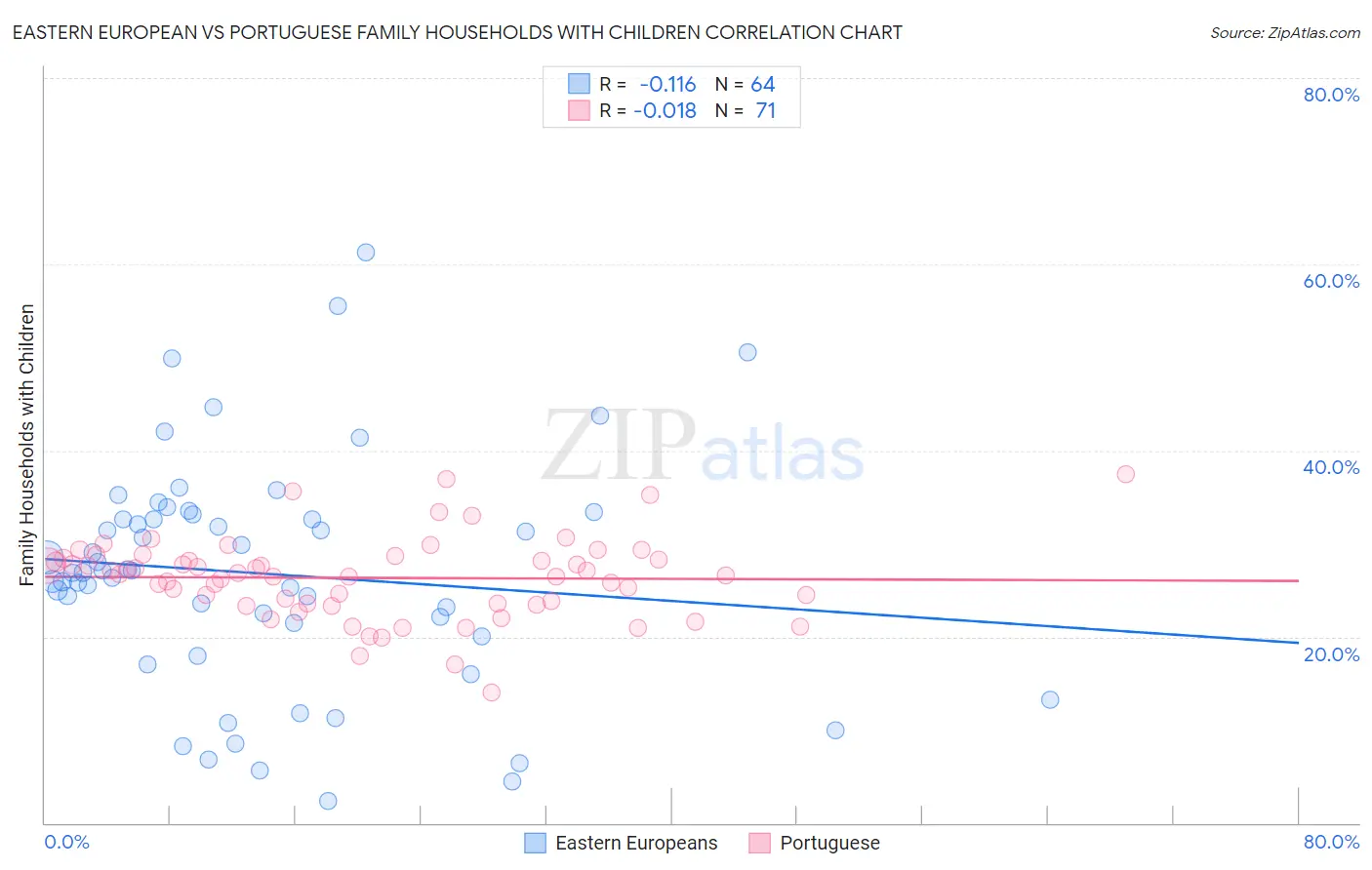Eastern European vs Portuguese Family Households with Children
COMPARE
Eastern European
Portuguese
Family Households with Children
Family Households with Children Comparison
Eastern Europeans
Portuguese
26.7%
FAMILY HOUSEHOLDS WITH CHILDREN
0.6/ 100
METRIC RATING
274th/ 347
METRIC RANK
27.6%
FAMILY HOUSEHOLDS WITH CHILDREN
77.8/ 100
METRIC RATING
151st/ 347
METRIC RANK
Eastern European vs Portuguese Family Households with Children Correlation Chart
The statistical analysis conducted on geographies consisting of 460,709,247 people shows a poor negative correlation between the proportion of Eastern Europeans and percentage of family households with children in the United States with a correlation coefficient (R) of -0.116 and weighted average of 26.7%. Similarly, the statistical analysis conducted on geographies consisting of 449,747,552 people shows no correlation between the proportion of Portuguese and percentage of family households with children in the United States with a correlation coefficient (R) of -0.018 and weighted average of 27.6%, a difference of 3.6%.

Family Households with Children Correlation Summary
| Measurement | Eastern European | Portuguese |
| Minimum | 2.3% | 14.0% |
| Maximum | 61.3% | 37.5% |
| Range | 59.0% | 23.5% |
| Mean | 26.8% | 26.3% |
| Median | 27.0% | 26.7% |
| Interquartile 25% (IQ1) | 20.7% | 23.5% |
| Interquartile 75% (IQ3) | 32.9% | 28.4% |
| Interquartile Range (IQR) | 12.1% | 4.9% |
| Standard Deviation (Sample) | 12.3% | 4.4% |
| Standard Deviation (Population) | 12.2% | 4.3% |
Similar Demographics by Family Households with Children
Demographics Similar to Eastern Europeans by Family Households with Children
In terms of family households with children, the demographic groups most similar to Eastern Europeans are Immigrants from Hungary (26.7%, a difference of 0.0%), Somali (26.7%, a difference of 0.040%), Immigrants from Northern Europe (26.7%, a difference of 0.090%), French (26.7%, a difference of 0.10%), and Immigrants from Zaire (26.7%, a difference of 0.11%).
| Demographics | Rating | Rank | Family Households with Children |
| Immigrants | Uzbekistan | 0.9 /100 | #267 | Tragic 26.7% |
| Immigrants | Belgium | 0.9 /100 | #268 | Tragic 26.7% |
| Immigrants | Denmark | 0.8 /100 | #269 | Tragic 26.7% |
| Immigrants | Zaire | 0.7 /100 | #270 | Tragic 26.7% |
| French | 0.7 /100 | #271 | Tragic 26.7% |
| Somalis | 0.7 /100 | #272 | Tragic 26.7% |
| Immigrants | Hungary | 0.6 /100 | #273 | Tragic 26.7% |
| Eastern Europeans | 0.6 /100 | #274 | Tragic 26.7% |
| Immigrants | Northern Europe | 0.5 /100 | #275 | Tragic 26.7% |
| Immigrants | Spain | 0.5 /100 | #276 | Tragic 26.6% |
| Celtics | 0.4 /100 | #277 | Tragic 26.6% |
| Immigrants | Europe | 0.4 /100 | #278 | Tragic 26.6% |
| Finns | 0.4 /100 | #279 | Tragic 26.6% |
| Senegalese | 0.4 /100 | #280 | Tragic 26.6% |
| Lithuanians | 0.3 /100 | #281 | Tragic 26.6% |
Demographics Similar to Portuguese by Family Households with Children
In terms of family households with children, the demographic groups most similar to Portuguese are Argentinean (27.6%, a difference of 0.020%), Ethiopian (27.6%, a difference of 0.030%), Immigrants from Moldova (27.6%, a difference of 0.040%), Osage (27.6%, a difference of 0.040%), and Menominee (27.6%, a difference of 0.040%).
| Demographics | Rating | Rank | Family Households with Children |
| Brazilians | 79.6 /100 | #144 | Good 27.7% |
| Immigrants | Chile | 79.5 /100 | #145 | Good 27.7% |
| Basques | 79.5 /100 | #146 | Good 27.7% |
| Immigrants | Moldova | 79.1 /100 | #147 | Good 27.6% |
| Osage | 79.0 /100 | #148 | Good 27.6% |
| Menominee | 78.9 /100 | #149 | Good 27.6% |
| Argentineans | 78.5 /100 | #150 | Good 27.6% |
| Portuguese | 77.8 /100 | #151 | Good 27.6% |
| Ethiopians | 77.0 /100 | #152 | Good 27.6% |
| Immigrants | Cabo Verde | 75.6 /100 | #153 | Good 27.6% |
| Icelanders | 75.3 /100 | #154 | Good 27.6% |
| Comanche | 74.8 /100 | #155 | Good 27.6% |
| Hungarians | 74.6 /100 | #156 | Good 27.6% |
| Indians (Asian) | 71.6 /100 | #157 | Good 27.6% |
| Romanians | 70.8 /100 | #158 | Good 27.6% |